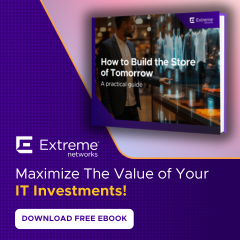CML – The benefits of overcoming omnichannel challenges for retailers
As the lines between retail channels become increasingly blurred, an omnichannel approach is quickly becoming a necessity for retailers who want to ensure they retain their customers and stay ahead of major competitors in today’s complex, multi-channel world.
As the lines between retail channels become increasingly blurred, an omnichannel approach is quickly becoming a necessity for retailers who want to ensure they retain their customers and stay ahead of major competitors in today’s complex, multi-channel world.
To achieve this, retailers are looking to gain a competitive edge through omnichannel retailing, allowing them to cut costs and improve sales, whilst maintaining high levels of quality and customer service. Whilst the upfront costs of omnichannel implementation can be high, the savings made through a more efficient use of stock will help to offset this over time, and puts retailers in a more comfortable position in the long term. Alongside cost savings, omnichannel retail also offers a wealth of other benefits and advantages to retailers who choose to invest in the systems and processes required for a successful operation.
Combined inventory and a single view of stock
A single view of stock and a central stock pool are fundamental aspects in making omnichannel fulfilment possible for retailers, however these systems can also offer compelling additional benefits once implemented.
Access to real-time inventory data is key in achieving a single view of stock and allows retailers to continuously measure sales and growth for each channel. This enables more accurate predictions of customer demands based on sales history across each channel, and a better chance to spot potential problems before they become major issues.
Harnessing this data can lead to greater efficiencies and means that over time, businesses can learn where best to place products for optimum profitability. Knowing where certain products will sell best can be a powerful advantage when it comes to older stock and sale season, as excess stock can be moved to a more profitable location, reducing the need for markdowns.
A clear, real-time overview of the entire stock pool also provides greater visibility and more precise inventory tracking, allowing businesses to benefit from faster and more accurate fulfilment. For a customer, there’s often nothing worse than finding out the item they’ve ordered is now out of stock and unable to be fulfilled. With a definitive view of all inventory, these issues can be avoided, and profits can be maximised across the network.
By enabling stock to be in the right place, at the right time, retailers provide a more seamless customer experience and ensure consistency across their brand and services no matter how buyers choose to shop.
Consistent customer experience
Maintaining a strong relationship with customers is at the heart of retailing, and providing high levels of customer service should always be a top priority. With multiple channels in which customers can interact with your brand, it’s important that the same levels of care and attention are translated across all platforms, giving customers the same high quality in brand experience across the board.
To enable a truly seamless experience for customers, it’s essential that personal details and information on previous transactions are made available across the network. This means that no matter whether a customer purchases an item in-store, online or through an app, this data is all stored in one single customer database, accessible at all touchpoints.
A clear view of each individual and their order history gives retailers added flexibility and means enquiries can be dealt with quickly and effectively. This also allows for extra agility when it comes to returns, so that customers are able to return their purchases through whichever channel is easiest for them, regardless of how it was originally ordered.
As consumers increasingly turn to online shopping, personalisation becomes more important than ever in the race to provide the same levels of customer service as the in-store experience traditionally has. With a comprehensive overview of each customers’ history and their purchasing habits across channels, businesses can tap into this data to provide a more tailored experience for individuals. When used in an intelligent way, this data can help to deliver more relevant marketing, offer personalised content, or smart vouchers for money off their favourite purchases and brands.
Fully integrated systems
The backbone of a successful omnichannel strategy is full integration between systems and the removal of silos within the information architecture. To enable the cross channel visibility that is required for many of the processes in an omnichannel framework, all channels must be fully integrated to allow them to provide accurate, real-time information across all channels.
In doing so, customer information, inventory amounts, product data and order details are made readily available across all touchpoints. This allows for better distribution of stock and the ability to better predict demand, avoid disruptions and spot gaps in supply. By drawing all of these separate data streams together, businesses gain improved visibility across their network, and in turn allow employees and systems to make more informed and accurate decisions.
Integration can also help to improve efficiencies, by reducing both the time and resources needed to manage multiple individual systems.
Repurpose stores to meet customer demands
Although e-commerce sales show no signs of slowing down and are rapidly overtaking those in store, a physical presence continues to be an important asset. Retailers now need to find a way to balance falling in-store sales to ensure these outlets remain profitable, and an omnichannel approach can provide the ideal solution.
Turning stores into fulfilment centres helps to keep stores relevant and offers a considerable competitive advantage to retailers with a well distributed store network. The latest technologies blur the lines between traditional stores and distribution centres, meaning orders can be fulfilled in a way that’s both highly profitable and also convenient for the customer too.
Utilising in-store fulfilment means businesses can dispatch items from the closest store to their customer, allowing for shorter delivery times and cutting delivery costs to the business significantly. Algorithms are used to ensure items are shipped from the most cost-effective location, whilst also ensuring stock remains available at the most profitable stores. This removes the need for safety stock at each individual location and allows for less overall inventory to be carried.
Alongside the speed and cost savings, this method also offers a much more efficient way to use stock and can help to prevent stores from becoming burdened with hard to sell items. By using store inventory to fulfill online orders, stores improve the visibility of their excess or unprofitable stock, giving them a higher chance of selling at full price and reducing the need for discounts.
To find out more information about CML please visit www.cmlplc.com














